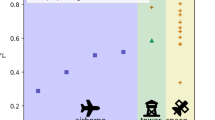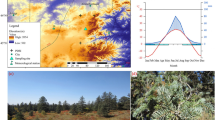Abstract
This study focuses on relationships between the phenological growing season of plant communities and the seasonal metrics of Normalized Difference Vegetation Index (NDVI) at sample stations and pixels overlying them, and explores the procedure for determining the growing season of terrestrial vegetation at the regional scale, using threshold NDVI values obtained by surface–satellite analysis at individual stations/pixels. The cumulative frequency of phenophases has been calculated for each plant community and each year in order to determine the growing season at the three sample stations from 1982 to 1993. The precise thresholds were arbitrarily set as the dates on which the phenological cumulative frequency reached 5% and 10% (for the beginning) and 90% and 95% (for the end). The beginning and end dates of the growing season were then applied each year as time thresholds, to determine the corresponding 10-day peak greenness values from NDVI curves for 8-km2 pixels overlying the phenological stations. According to a trend analysis, a lengthening of the growing seasons and an increase of the integrated growing season NDVI have been detected in the central part of the research region. The correlation between the beginning dates of the growing season and the corresponding threshold NDVI values is very low, which indicates that the satellite-sensor-derived greenness is independent of the beginning time of the growing season of local plant communities. Other than in spring, the correlation between the end dates of the growing season and the corresponding threshold NDVI values is highly significant. The negative correlation shows that the earlier the growing season terminates, the larger the corresponding threshold NDVI value, and vice versa. In order to estimate the beginning and end dates of the growing season using the threshold NDVI values at sites without phenological data from 1982 to 1993, we calculated the spatial correlation coefficients between NDVI time-series at each sample station and other contiguous sites year by year. The results provide the spatial extrapolation area of the growing season for each sample station. Thus, we can use the threshold NDVI value obtained at one sample station/pixel for a year to determine the growing season at the extrapolation sites with a similar vegetation type for the same year.
Similar content being viewed by others
Author information
Authors and Affiliations
Additional information
Received: 25 October 2000 / Revised: 19 June 2001 / Accepted: 19 June 2001
Rights and permissions
About this article
Cite this article
Chen, X., Xu, C. & Tan, Z. An analysis of relationships among plant community phenology and seasonal metrics of Normalized Difference Vegetation Index in the northern part of the monsoon region of China. Int J Biometeorol 45, 170–177 (2001). https://doi.org/10.1007/s004840100102
Issue Date:
DOI: https://doi.org/10.1007/s004840100102




